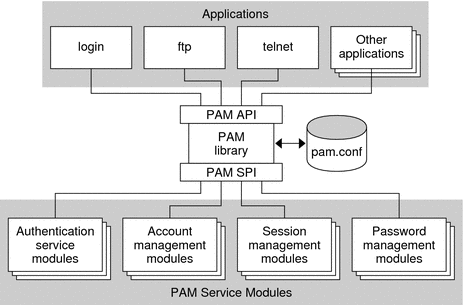|
|||
|
1. Security Services (Overview) Part II System, File, and Device Security 2. Managing Machine Security (Overview) 3. Controlling Access to Systems (Tasks) 4. Virus Scanning Service (Tasks) 5. Controlling Access to Devices (Tasks) 6. Using the Basic Audit Reporting Tool (Tasks) 7. Controlling Access to Files (Tasks) Part III Roles, Rights Profiles, and Privileges 8. Using Roles and Privileges (Overview) 9. Using Role-Based Access Control (Tasks) 10. Role-Based Access Control (Reference) Part IV Solaris Cryptographic Services 13. Solaris Cryptographic Framework (Overview) 14. Solaris Cryptographic Framework (Tasks) 15. Solaris Key Management Framework Part V Authentication Services and Secure Communication 16. Using Authentication Services (Tasks) 19. Using Solaris Secure Shell (Tasks) 20. Solaris Secure Shell (Reference) 21. Introduction to the Kerberos Service 22. Planning for the Kerberos Service 23. Configuring the Kerberos Service (Tasks) 24. Kerberos Error Messages and Troubleshooting 25. Administering Kerberos Principals and Policies (Tasks) 26. Using Kerberos Applications (Tasks) 27. The Kerberos Service (Reference) 28. Solaris Auditing (Overview) 29. Planning for Solaris Auditing 30. Managing Solaris Auditing (Tasks) |
PAM (Overview)The Pluggable Authentication Module (PAM) framework lets you “plug in” new authentication services without changing system entry services, such as login, ftp, and telnet. You can also use PAM to integrate UNIX login with other security mechanisms such as Kerberos. Mechanisms for account, credential, session, and password management can also be “plugged in” by using this framework. Benefits of Using PAMThe PAM framework enables you to configure the use of system entry services (such as, ftp, login, telnet, or rsh) for user authentication. Some benefits that PAM provides are as follows:
Introduction to the PAM FrameworkThe PAM framework consists of four parts:
The framework provides a uniform way for authentication-related activities to take place. This approach enables application developers to use PAM services without having to know the semantics of the policy. Algorithms are centrally supplied. The algorithms can be modified independently of the individual applications. With PAM, administrators can tailor the authentication process to the needs of a particular system without having to change any applications. Adjustments are made through pam.conf, the PAM configuration file. The following figure illustrates the PAM architecture. Applications communicate with the PAM library through the PAM application programming interface (API). PAM modules communicate with the PAM library through the PAM service provider interface (SPI). Thus, the PAM library enables applications and modules to communicate with each other. Figure 17-1 PAM Architecture
Changes to PAM for the Solaris 10 ReleaseThe Solaris 10 release includes the following changes to the Pluggable Authentication Module (PAM) framework:
Changes to PAM for the Solaris Express 1/06 ReleaseThe PAM framework for the Solaris Express 1/06 release includes a new pam_allow module. The module can be used to grant access to all users, without enforcing any security. The module should be used with caution. For more information, see the pam_allow(5) man page. |
||
|